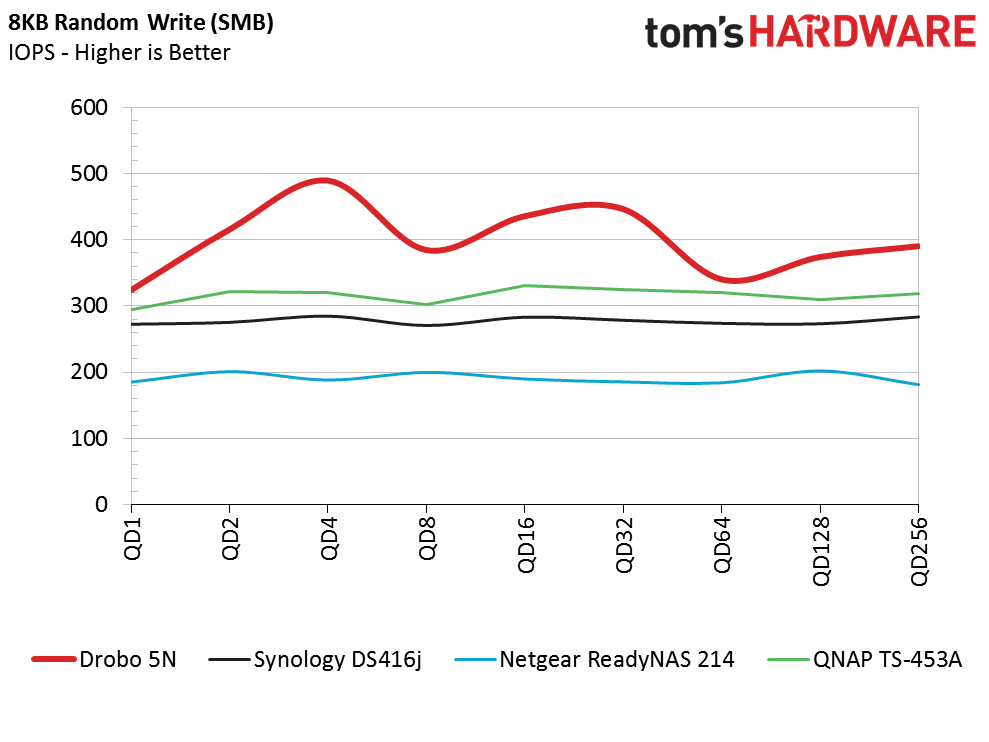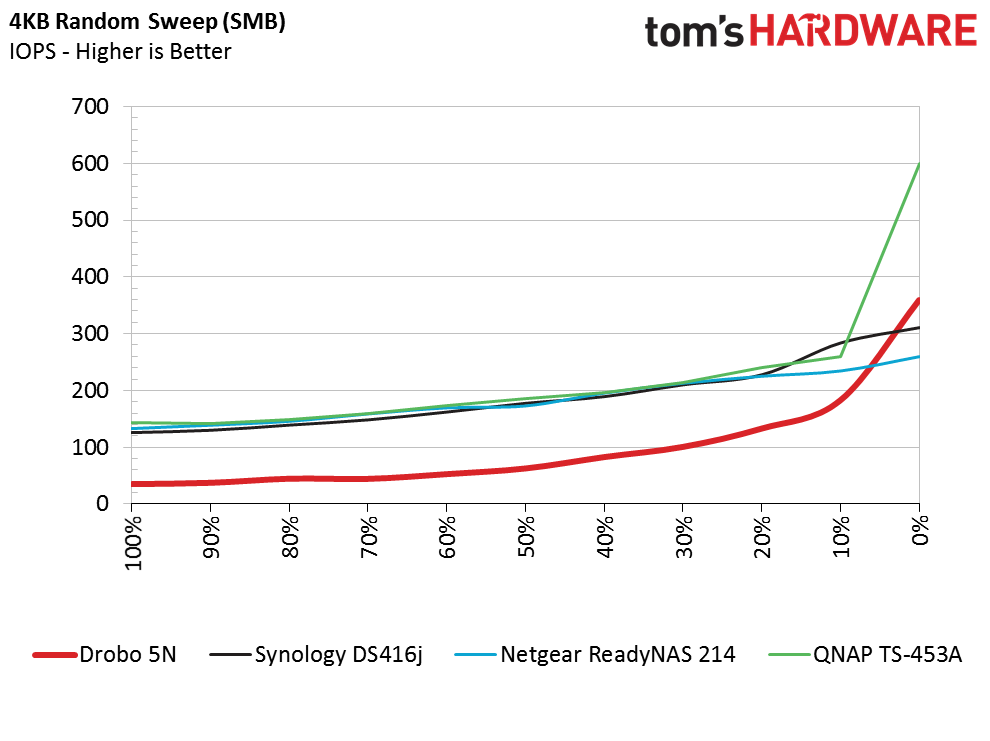Drobo 5N 5-Bay NAS Review
Why you can trust Tom's Hardware
Four-Corner Performance Testing
Testing Notes
All of the systems under test use traditional SMB/CIFS file transfers. SMB is the easiest NAS protocol because it simplifies file access to where you can simply type in "\\name_of_nas\folder_name" in file explorer to access the data on the system. We test and highlight the performance of SMB encrypted folders and iSCSI volumes on applicable models, but not all systems support the features.
Our test system is a modified Quanta MESOS CB220 Cluster-In-A-Box multi-node server. We upgraded the system with two Intel E5-2670 V1 processors and 128GB of system memory per node. An Intel X520 network interface card with two 10GbE ports resides in each node, as well. The system allows us to deploy four test nodes that execute custom software scripts in industry standard test software to measure our base performance metrics.
The test system and devices under test connect via a Netgear M6100 fully-modular switch, which provides ample 10GbE and 1GbE ports to sustain our large testing environment. This round of NAS testing is the second time we've used this switch. We discovered an issue with our previous switch and some NAS products that significantly reduced file transfer performance. The Netgear M6100 doesn't give us the same performance issues, and it allows us to expand our test environment while still running a dedicated network.
Comparison Products
The feature-rich QNAP TS-453A is the only one of the four NAS in the test pool that we have covered in a dedicated review. It, as well as the Synology DS416J and Netgear ReadyNAS 214, are four-bay systems with prices that range between $289 and $599. The Synology DS416j and Netgear ReadyNAS 214 reviews are still in flight.
Sequential Read



At low queue depths, the Drobo 5N transfers data at a lower rate than the other systems on the comparison list. The 5N comes alive with eight outstanding IO and matches the other systems at most block sizes during the read-centric workload.
Sequential Write



Most file transfer to your NAS are sequential, unless you use it for hosting virtual machines or other advanced workloads. Again, we see that low queue depth sequential transfers, this time to the NAS, are slower on the 5N compared to many of the other systems. At higher queue depths, the 5N closes the gap and even outperforms some of the other systems.
Sequential Mixed Workloads




Nearly all consumer-focused storage products lose performance when you mix data writes with data reads. Mixed workloads cause severe performance degradation that the mechanical hard disk drives amplify due to the way they work. An equal mix of reads and writes is the most troublesome for hard disk drives. It's easy to replicate this state by simply reading one file from the NAS while writing another. The impact is even more severe if you increase the workload with multiple simultaneous transfers to and from the system.
Get Tom's Hardware's best news and in-depth reviews, straight to your inbox.
Some network-attached storage systems use the system memory to buffer incoming data, a process that eases the bathtub curve and increases performance. The Drobo 5N with 2GB of system memory doesn't appear to use the same algorithm, or the buffer set aside for the cache fills faster than our test measures.
Random Read



Marvell SoC processors are not known for exceptional random performance. Adding liberal doses of system memory helps to increase performance, but with only 2GB, the Drobo 5N has trouble reading back random data to the host computer. If you run applications from the 5N, the responsiveness will feel slower than if the data came from an internal hard drive.
Random Write



The Drobo 5N fares much better than the other systems during the random write workload. The line showing performance isn't as smooth as the others, largely due to the impact of the cache.
Random Mixed Workloads




The high random write performance doesn't save the Drobo 5N from falling short with random mixed workloads. The tests in this section will carry over to the application workloads on the next page, which measure performance when we have software running from the NAS.
Current page: Four-Corner Performance Testing
Prev Page A Closer Look Next Page Real World Software Workloads
Chris Ramseyer was a senior contributing editor for Tom's Hardware. He tested and reviewed consumer storage.
-
jasonelmore Pretty weak CPU, no way it's doing any PLEX Server duties. That's kind of a must have features nowadays. Although this NAS is around 3 years old, odd that toms is just now reviewing it.Reply -
azaran Kinda odd to see this up and running in a review when its been out for so long. It's 3+ yr old tech in this thing so its not surprising that its not wowing anyone with its specs. I love mine tho.Reply -
BenJaD Difficult to recall how long the 5N has graced my storage space. As a recovering DP manager from the era of big iron and big budgets I had zero interest in becoming a networking wizard. The 5N has done everything I needed from it - and Drobo has routinely provided both hardware and software updates that, as far as I can tell, keep the device relevant. What I purchased as a 15Tb device is now capable of 30Tb, and possibly 40Tb.Reply
Do I appreciate the 'aged' technology - you better believe I do. The last major shop I ran the available storage on this device would be the biggest budget bomb ever - . -
Robert_6966 I've had mine for three years and I love it. It has worked flawlessly during that time, including having two hard drive failures ( cheap drives ). I'm now running five 4TB WD red NAS drives. I have this drive attached to a small PC running Plex = awesome!Reply -
John McGaw I've been using mine since June of 2013 and have found it an excellent backup destination. I started with two 3tB WD Red drives then filled up with three more and when the space started to get tight I stuffed in two 6tB. The drive upgrade process, while slow with huge drives, has always run perfectly. I used to be a UNIX sysadmin before retiring and really didn't want to get into any complexities at home -- the Drobo filled the bill and saves headaches and worries.Reply




